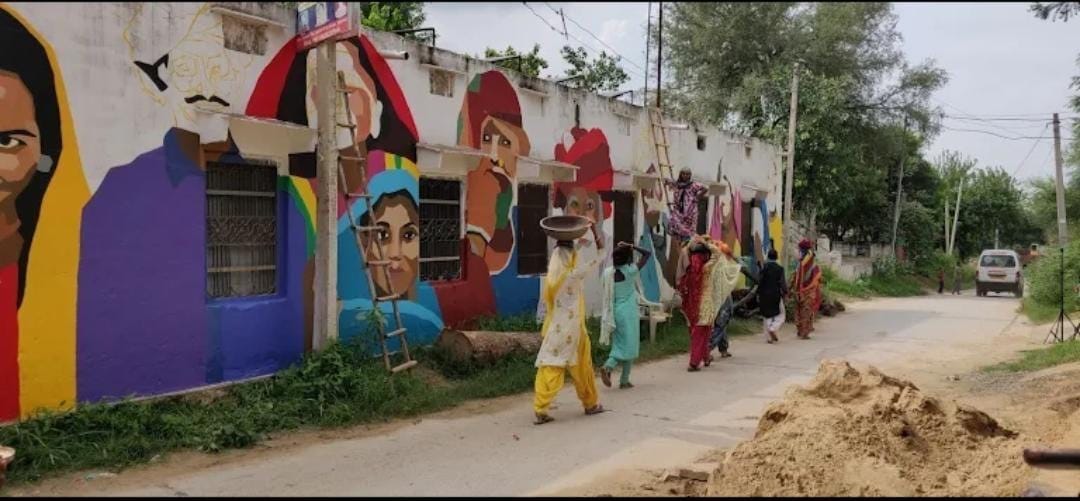
Art Finds You
Share

People’s museums, one wall at a time
Art doesn’t always announce itself with a spotlight or a price tag. Sometimes it shows up quietly- painted on a shutter, stenciled on a street corner, made from trash. And when it does, it often reaches people who weren’t even looking for it.
That’s part of the shift we’re seeing: public art becoming a gentle intervention in everyday life. Not a protest, always. Not a performance, exactly. But something in between- a way to say: look closer, this matters.
And in a world where museum entry fees in metro cities range from INR 150 to INR 500, art that appears in public- without ticketing, without gatekeeping, can feel like its own kind of access.
From sustainability murals to protest walls, from queer collectives to Instagram galleries, here we look at art that meets us where we are.
Trash, repurposed. Beauty, redefined.

Vishwanath Mallabadi didn’t start as an artist. He was a design professional who got tired of watching electronic waste pile up with no plan and no poetry. So he started collecting- circuit boards, old remotes, broken chargers- and turning them into sculptures and murals.
One of his largest pieces, a 25-foot mural in Orion Mall, uses nothing but discarded tech to form a majestic peacock. It isn’t just decorative. It asks questions. What happens to what we throw away? How do we reuse what feels obsolete? Can beauty emerge from a scrap heap?
Mallabadi once said: “Public spaces should breathe art.” That line stays with you. Not just for what it says about creativity, but for how it reframes who art is intended for.
India generates over 1.6 million tonnes of e-waste annually. His murals don’t solve that. But they remind us. Gently.
Protest walls that talk back

We’ve seen how public art holds protests without always shouting. Think of the Fearless Girl sculpture in New York- facing down the Wall Street bull, not with aggression but with a firm stance, arms akimbo. It doesn’t scream. But it shifts the tone.
In Delhi, during the anti-CAA movement, the walls of Shaheen Bagh were transformed. What began as slogans turned into something else: poetry, portraits, angry jokes, longings for safety. Artists and students painted overnight, adding bursts of colour to a winter-long sit-in.
And far away in Gaza, street art continues to emerge amid rubble-calls for justice, memory, and mourning on broken walls. These aren’t gallery works. They weren’t commissioned. But they live. They resonate. They circulate online, tagged and shared. Even if the paint fades, the image doesn’t.
Queer colour on concrete

In India, art collectives like the Aravani Art Project are claiming wall space in an entirely different way. Led by trans and queer artists, they create murals that celebrate gender diversity and visibility- not just as identity politics, but as everyday expression.
One of their works shows figures in bright sarees, surrounded by flora and open skies. The style is celebratory. The message is subtle but firm: we’re here, we belong. As one member shared in an interview, “We don’t need permission to be visible.”
What does it mean to see yourself reflected on a wall you walk past every day? Maybe it’s safe. Maybe it’s pride. Maybe it’s just relief.
Screens as walls, stories as posts
It’s not just physical spaces that carry these stories. Instagram, for all its chaos, has become a living museum of the fleeting and the undocumented. Hashtags like #FearlessGirl and #GazaArt holds images together, linking murals across continents.
An artist in Jaipur might post a reel of a back-alley mural that gets picked up by a curator in London. A queer collective might receive a commission after a post goes viral. And in a world where India reportedly watches over 200 billion Instagram Reels per month, that kind of reach isn’t small.
Even institutions are adapting. Virtual walkthroughs, live Q&As, and “museum-in-your-pocket” initiatives are becoming more common. Maybe the real shift isn’t between digital and physical, but between exclusive and everyday.
Call to the street
By dusk, the light on Hosur Road changes. The mural catches it differently- circuit tiles glint under the glow of passing scooters. A group of kids shine a phone flashlight at the peacock, giggling as they pose for a photo.
Most of them won’t know who made it. But the art doesn’t ask for that. All it wants is a moment of their commute. Whether in a gallery or on a side street, the invitation stands-look up, look around.

